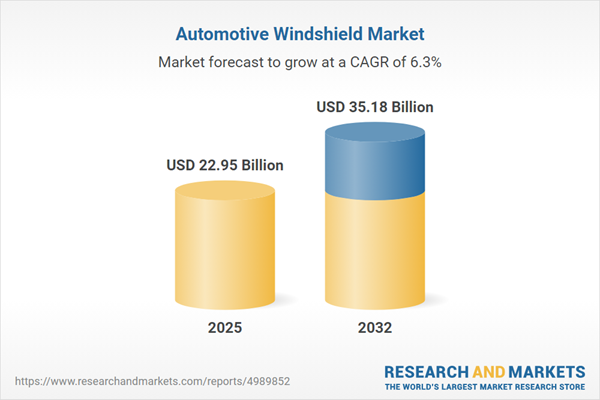Speak directly to the analyst to clarify any post sales queries you may have.
The automotive windshield market is advancing through continuous technology integration and innovation, reflecting rapid shifts in mobility, regulatory priorities, and consumer preferences.
Market Snapshot: Automotive Windshield Market Overview
The Automotive Windshield Market grew from USD 21.57 billion in 2024 to USD 22.95 billion in 2025. It is expected to continue growing at a CAGR of 6.30%, reaching USD 35.18 billion by 2032. This growth is shaped by increasing adoption of advanced driver assistance systems, evolving regulatory requirements for vehicle safety, and heightened consumer expectations for integrated functionalities and comfort.
Scope & Segmentation
This report provides detailed analysis and forecasts across key segments and regions, highlighting pressing trends in automotive glazing technologies, supply chain adjustments, and end-user demand.
- Glass Type: Laminated Tempered
- Sensor Integration: With Sensor Integration Camera System Light Sensor Rain Sensor Without Sensor Integration
- Technology: Acoustic Heated Standard UV Protection
- Vehicle Type: Heavy Commercial Vehicles Light Commercial Vehicles Passenger Cars
- Distribution Channel: Aftermarket Original Equipment Manufacturer
- Regional Coverage: Americas North America (United States, Canada, Mexico) Latin America (Brazil, Argentina, Chile, Colombia, Peru) Europe, Middle East & Africa Europe (United Kingdom, Germany, France, Russia, Italy, Spain, Netherlands, Sweden, Poland, Switzerland) Middle East (United Arab Emirates, Saudi Arabia, Qatar, Turkey, Israel) Africa (South Africa, Nigeria, Egypt, Kenya) Asia-Pacific (China, India, Japan, Australia, South Korea, Indonesia, Thailand, Malaysia, Singapore, Taiwan)
- Leading Companies: Fuyao Glass Industry Group Co., Ltd. AGC Inc. Nippon Sheet Glass Co., Ltd. Compagnie de Saint-Gobain S.A. PPG Industries, Inc. Xinyi Glass Holdings Limited Guardian Industries Corp. Türkiye Şişe ve Cam Fabrikalari Anonim Şirketi Vitro, S.A.B. de C.V. Cardinal Glass Industries, Inc.
Automotive Windshield Market: Key Takeaways
- Innovation in laminated and tempered glass constructions is targeting improved occupant safety, noise reduction, and lighter vehicle frameworks to support fuel efficiency and emissions goals.
- Sensor integration, such as cameras, rain, and light sensors, is driving the windshield’s evolution into an intelligent vehicle interface, supporting advanced safety and convenience features.
- Emergent technologies include heated elements, acoustic interlayers, and UV-protective coatings, enabling comfort and durability even in demanding climates or long-haul operations.
- Sustainability remains a priority with increased adoption of recycled glass and exploration of bio-based interlayer materials, aligning with regulatory and OEM environmental objectives.
- Demand for panoramic, curved, and electronically dimmable windshields is rising, driven by design trends and the need for seamless sensor and infotainment integration in premium segments.
- Supply chain adaptation is intensifying, especially in regions under shifting trade policies or tariffs, leading to more localized manufacturing and collaborative material innovation.
Tariff Impact: Navigating New Trade Dynamics
Recent U.S. tariffs on float glass and polymer interlayers are prompting automakers and suppliers to reevaluate global sourcing, prioritize domestic material qualification, and increase reliance on local producers. Tier-1 assemblers are adopting nearshoring and inventory strategies to minimize risks and optimize logistics. In parallel, investments in U.S. production capacities, advanced coatings, and automation systems are reshaping cost structures and driving process efficiency. These actions are not only mitigating immediate cost pressures but also enhancing long-term supply chain resilience.
Methodology & Data Sources
The research combines direct interviews with industry experts and procurement leaders, supported by in-depth analysis of technical publications, regulatory filings, and patent literature. Data triangulation ensures consistency, while both top-down and bottom-up assessment approaches align insights from supply chain data and regional adoption rates.
Why This Report Matters
- Enables executive-level decision-making with clear segmentation by product type, technology, and geography.
- Provides actionable intelligence on supply chain optimization and risk mitigation in a dynamic regulatory environment.
- Supports innovation and procurement strategies by detailing prevailing and emerging technologies in automotive glazing.
Conclusion
The automotive windshield market is rapidly transforming into a critical technological interface within vehicles. Senior leaders who prioritize innovation, resilient supply chains, and regionally tailored strategies will be positioned for sustainable growth as the industry advances.
Additional Product Information:
- Purchase of this report includes 1 year online access with quarterly updates.
- This report can be updated on request. Please contact our Customer Experience team using the Ask a Question widget on our website.
Table of Contents
3. Executive Summary
4. Market Overview
7. Cumulative Impact of Artificial Intelligence 2025
Companies Mentioned
The companies profiled in this Automotive Windshield market report include:- Fuyao Glass Industry Group Co., Ltd.
- AGC Inc.
- Nippon Sheet Glass Co., Ltd.
- Compagnie de Saint-Gobain S.A.
- PPG Industries, Inc.
- Xinyi Glass Holdings Limited
- Guardian Industries Corp.
- Türkiye Şişe ve Cam Fabrikalari Anonim Şirketi
- Vitro, S.A.B. de C.V.
- Cardinal Glass Industries, Inc.
Table Information
| Report Attribute | Details |
|---|---|
| No. of Pages | 196 |
| Published | October 2025 |
| Forecast Period | 2025 - 2032 |
| Estimated Market Value ( USD | $ 22.95 Billion |
| Forecasted Market Value ( USD | $ 35.18 Billion |
| Compound Annual Growth Rate | 6.3% |
| Regions Covered | Global |
| No. of Companies Mentioned | 11 |









